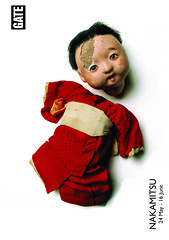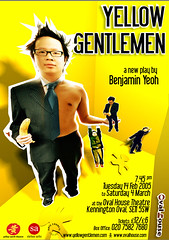Noh notes, Kyogen
Some short notes I’ve written to put my version of Nakamitsu in context.
*
In general, many Japanese Noh plays are not “very dramatic” in the Aristotelian sense. However they are beautiful. Noh plays are full of poetical allusions and the dances, though slow, are elegant. There is abstraction in Noh and indeed it is discouraged to appear to imitate the external forms of people and objects too closely, concentrating rather on the essence or soul which the actor will attempt to recreate.
Western theatre and television are strongholds of naturalistic performances. Television is often a version of a transcript of life. Noh does not follow realism. Symbols and gestures; music and poetry; a language of physicality; these are all important.
Language
Noh plays are written partly in prose and partly in verse. Sections are chanted. The language of a prose passage often will heighten into verse.
In a classical performance, an old dialect of Japanese is used which is often difficult for a modern Japanese audience to understand without programme notes.
The poetry of Noh is dense and complex despite an often restricted vocabulary. Cascades of images and words echo one another visually, in meaning, and sound. Translators try to do their best but it is said even scholars do not always grasp the heart of such poetry.
Persons speaking for one another
Japanese avoids specifying grammatical subject. Nouns have no plural form. Verbs are invariant to person or number. The subject of a verb can be hard to determine with certainty.
In Noh, the concept of the character or person may not be distinct. Sometimes actors speak for one another although a translation into grammatical English makes this less vague. In chorus passages, a choice must be made from line to line on who should deliver the words.
Importantly, a speaker who seems to be in a first person mode of address may suddenly change to a third person mode in order to narrate his or her own actions. This often happens at heightened moments of emotion or drama and should be accepted as part of the special qualities of a Noh play.
Length
Noh texts are short. They take ten to twenty minutes to read out. In classical Noh, today, a short performance would take about an hour and some plays can take over two hours. Some dances can be prolonged a long time and delivery is slow. Historically, in the 1400s, plays seem to have been performed in half the time or less than they take now.
*
Schools of Noh
The “schools” of Noh are hereditary lineages of shite actors. Each school has its characteristic style. Details of music, dance, singing, staging and text will vary from school to school. Each school will have a “normal” way of presenting a play but several plays will also have named performance variants.
Presentation and categorisation of Noh
Noh plays are usually placed into one of five categories. However different schools may give different classifications. The first category of plays are often called “god plays”. The shite is a god who praises the peace and prosperity of the land and performs a dance in celebration. The second category are “warrior plays”. The shite is usually a famous warrior and often appears as a ghost. The third category are often called “woman plays” although the shite is not always a female character. Fourth category plays are difficult to define. Some times called “madman plays” they often fall in to an “other” category and are often concerned with characters in present life (as opposed to ghosts). Fifth category plays are called “concluding plays” or “devil plays” as the shite can be a devil and these plays finish a complete programme of Noh.
Historically, a complete Noh programme would be made by choosing a play from each category and performing them in that order with Kyogen plays interspersed between. Today in a Noh programme in Japan, often only two or three Noh plays are performed still with Kyogen in between.
Kyogen
Kyogen is the classical comedy theatre art of Japan, however a Kyogen performance may not always be comic. It has been passed down in its present form back to back with Noh drama. Its name is created from the Japanese writing characters for “crazy” or “totally involved in” (kyo) and “speaking or “words” (gen). It is often considered a physical and comedic counterpoint to Noh although it is an art in its own right. A Kyogen play is much shorter than a Noh performance and often averages about twenty minutes.
comments
One Response to “Noh notes, Kyogen”


[...] The Whingers did not, for example, understand the significance of the opening scene in which a man dressed as a schoolboy did a striptease and ate a banana (live fruit eating on stage – again!) so they made Yeoh explain it to them in words of one syllable in the pub downstairs afterwards. But if they had bothered to read the amazingly helpful programme which contains notes on Noh and the complete “text” for £3 they could have answered their own questions (the notes are also here) and, anyway, it didn’t matter because the rest of it was a breeze. [...]